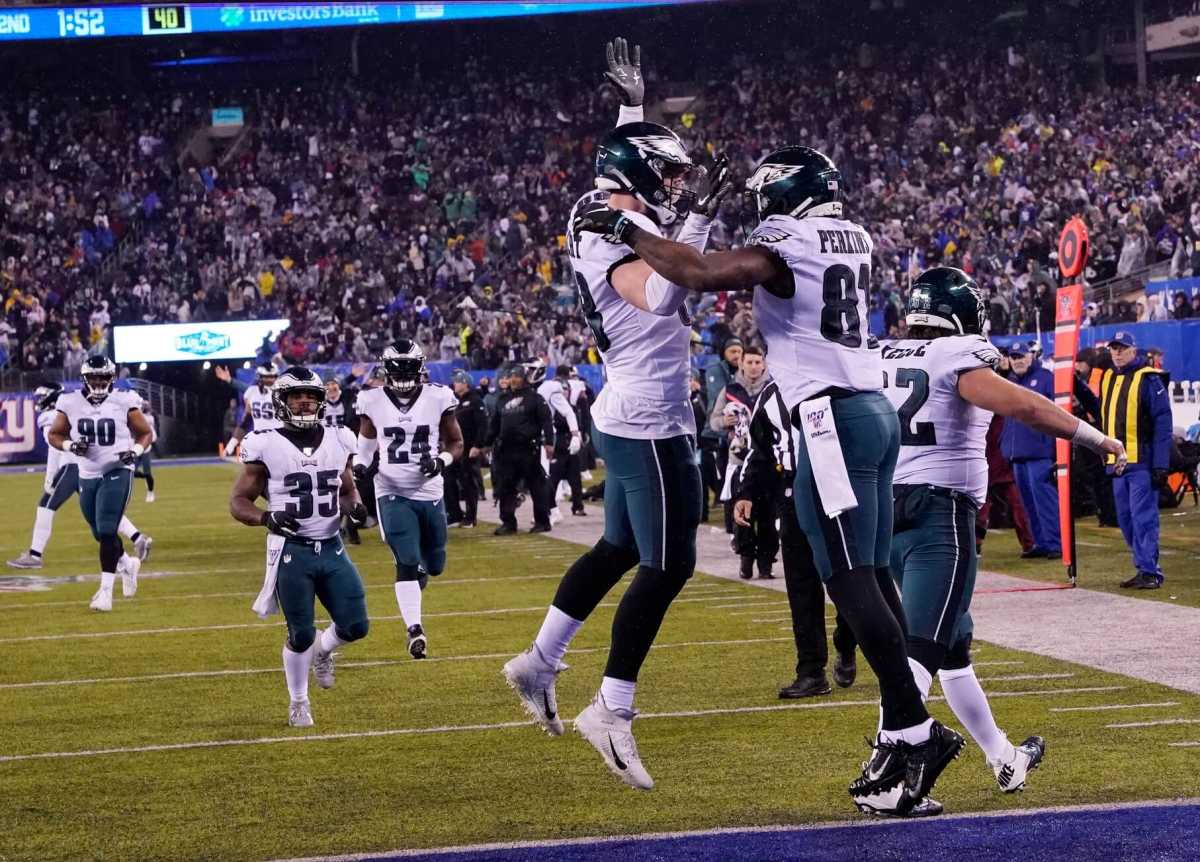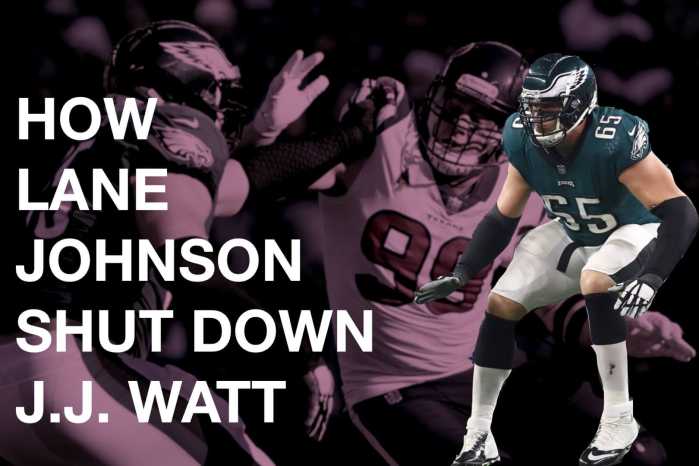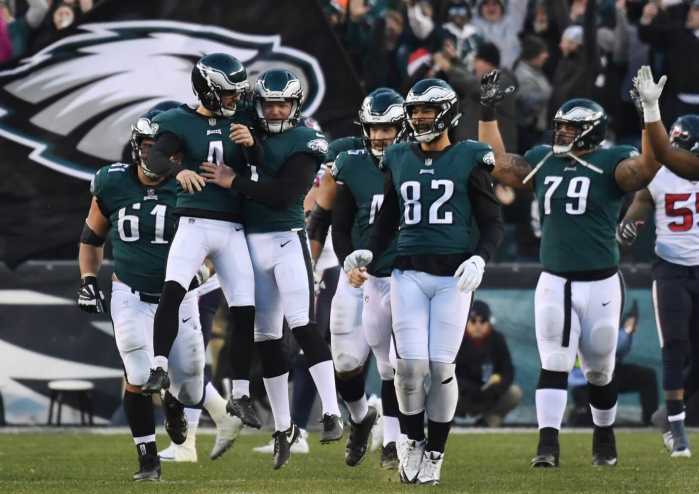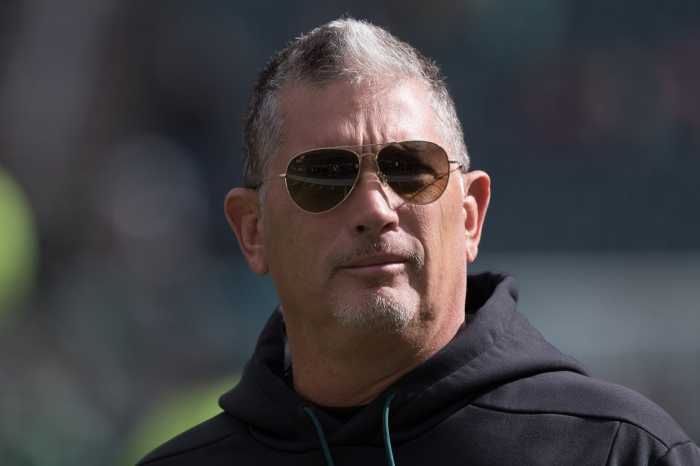Line vs. Line
Seattle has a host of massive offensive linemen, and are able to overpower opponents. They are rarely stuffed at the line of scrimmage (9th) and get to the second level with frequency (6th). They have gotten an equal return from their line and backs, averaging 2.3 yards before contact and 2.3 yards after contact.
| Football Outsiders | Seahawks’ | Offence | Eagles’ | Defense |
| Adjusted Line Yards | 4.32 | 15th | 3.43 | 3rd |
| RB Yards | 4.61 | 9th | 3.72 | 4th |
| Power Success | 68% | 10th | 67% | 22nd |
| Stuffed | 18% | 9th | 26% | 3rd |
| 2nd Level | 1.33 | 6th | 1.00 | 4th |
| Open Field | 0.93 | 13th | 0.87 | 23rd |
The visitors will face a tough test against a ferocious Eagles defensive line. Philly has the 3rd most efficient defensive line and have been able to limit backs at a similar rate. They habitually halt plays at the line of scrimmage (3rd) and close the gap at the second level (4th).
However, the downhill nature of Jim Schwartz’ scheme makes them vulnerable to pulls and big breakdowns in gap control. Thus the 23rd overall ranking in open field yards and 22nd rank against powers. The Eagles will have to stay disciplined on defense. This includes their young group of linebackers and defensive ends — who have been susceptible to overplays and misdirection this season.
The Seahawks’ run game has been at its best when it can get outside opposing linemen (2nd to the left, 7th to the right). However, this is a tool they rarely bring out of the belt — surprising when considering how awful they have been running the ball up the gut (29th). That may change on Sunday against an incredible interior run defense in Philly. In general, Seattle has been better running to the right, where the Eagles house one of their best defenders in Brandon Graham.
| Rank | Frequency | Rank | Frequency | |||
| Left End | 5.38 | 2nd | 12% | 3.77 | 10th | 17% |
| Left Tackle | 4.30 | 17th | 11% | 2.95 | 2nd | 14% |
| Center/Guard | 3.87 | 29th | 54% | 3.43 | 4th | 43% |
| Right Tackle | 4.79 | 8th | 16% | 3.79 | 10th | 10% |
| Right End | 5.08 | 7th | 7% | 3.25 | 10th | 16% |
The Philadelphia defense is predicated on stopping the run, so it’s no wonder they have been difficult to exploit in any particular direction. They are in the top 10 in every positional category. They are so good in the interior that teams only target the middle on 43% of their runs.
Opponents have instead attempted to stress the Eagles laterally, to mild success. All in all, this is a very stingy run defense. Nevertheless, they did struggle to contain Rashaad Penny in their last meeting with the Seahawks. Penny finished with 129 yards and a touchdown on 14 carries (9.2 yards per). While Penny will not play on Sunday, Homer has similar speed and cannot be taken lightly.
RBs
Seattle will undoubtedly miss Chris Carson, who has been electric all season. Nevertheless, they have seemingly been able to churn out yards regardless of who is in the backfield. Marshawn Lynch isn’t the same back as he was in his last stint with the Seahawks, but he is always capable of a highlight reel burst. He’s also astute at breaking tackles, a category in which the Seahawks ranked 10th this season (38 total). That’s a broken tackle every 12.7 attempts (13th).
Seattle also has Russell Wilson on their roster, who is always a threat to run for a big gain. This year has been relatively quiet for Wilson’s rushing numbers and he still managed 342 yards and 3 touchdowns on the ground.
The Eagles’ defense has been okay at containing quarterbacks, allowing just 214 rush yards (11th). They have also limited running backs to just 1113 rush yards (4th) and 10 rushing touchdowns (14th). The team has created 80 tackles for loss (11th) and has been a solid tackling group. They have only missed 97 tackles all season — it seems like more — which is the 7th fewest.
RPO/ Play Action
Seattle is also fond of RPOs and play-action. They ran 99 RPO plays this season (7th) for a total of 535 yards (10th). However, Wilson handed the ball off much more frequently than he threw it (38:61).
They deploy a lethal play-action game as well. In 135 play-action passes (8th) Seattle managed 1059 pass yards (9th). That is almost a full yard and a half per play more than the Eagles average; to put it in perspective. The Eagles corners cannot afford to bite.
Bottom Line
Eagles’ Offence vs. Seahawks’ Defense
The key for the Eagles is simple: sustain long drives and limit turnovers. The Seahawks defense has been susceptible to long drives, allowing an average of 5.9 plays per possession — 21st in the league. That’s due in part to the team allowing a 38.4% conversion rate on 3rd downs (16th) and — if it comes to it — a 58.3% conversion rate on 4th (25th) on just 12 total attempts. Expect Doug to consider every opportunity on 4th down, especially in short yardage situations.
If the Eagles can get the ball inside the red zone, they will have the advantage of facing the leagues 26th ranked red zone defense. The Seahawks allow touchdowns on 61.5% of their opponents’ red zone possessions. Conversely, the Eagles have been the 3rd best red zone offence in the league, turning 66.7% of their red zone possessions into touchdowns. Over the last three games, the team has upped that number to 75%. Carson Wentz has been on fire inside the 20, converting 59.42% of his passes for 19 touchdowns and zero interceptions. The secret weapon may be Boston Scott, who has made the most of his red-zone touches, lowering his shoulder for 5 touchdowns on just 12 carries inside the 20.
Overall, the Seattle defense doesn’t look that impressive on paper, but it has been their ability to force turnovers that have kept them afloat. They create turnovers on 16.2% of their opponents’ offensive possessions, which is 4th in the league. Of course, you have to create turnovers when you allow opponents 2.02 points per possession, 19th in the league. If the Eagles can limit turnovers and carry drives into the red zone, they stand a very good chance against this Seattle defense.
X-factor: There are many, but it will all come down to Carson Wentz’ fumbling issue. Last time the two teams faced off Wentz fumbled the ball three (three!) times and lost two of them. It simply can’t happen this time around. It seems like a game that will come down to three or four big plays and an untimely fumble from Carson has too often been the deciding factor this season.
Seahawks’ Offense vs. Eagles’ Defense
For the Eagles’ defense, the goal has to be to limit big plays and force the Seahawks to kick field goals. Seattle converts on 39.5% of their third-down opportunities (16th) — 36.11% over the last three games — but managed to convert 57.14% of their 3rd downs against the 49ers defense last week. Overall, that’s a very manageable number if the Eagles are able to get there. They cannot afford big plays on early downs.
If Philadelphia is able to force third downs, they will have the benefit of leaning on their 4th ranked 3rd down defense, allowing a conversion rate of just 34.15%. In the last three games that number fell to 30.00%. Home field advantage will also be a factor at the Linc, where opponents have converted just 28.7% of their third-down tries.
Adding to those fantastic numbers, the Eagles allow scoring drives on only 33.5% of opponent’s possessions (8th). However, they have a turnover rate of just 10.1% (20th) — re-emphasizing the fact that they will have to stop the Seahawks on third down. Luckily, Philly has been good at limiting drives, allowing an average of just 5.3 yards per drive (5.3 plays). Although, that has a much to do with giving up big plays as it does playing good defense. If Pete Carroll does decide to go for it on 4th down, the Eagles could be taken advantage of. They have allowed a conversion rate of 61.1% on fourth down this season (27th).
In the red zone, the advantage will go to the Seahawks. They convert on 63.33% of their red zone possessions; a number which has risen to 72.73% over the last three games. That is in large part due to Russell Wilson’s 25 red zone touchdowns. The Eagles will have a chance to limit him, as Wilson has a completion percentage of only 49.44% inside the 20. However he has only thrown one interception. Wilson is also much better inside the 10 where he has thrown 15 touchdowns with a 60.61% completion rate.
The Eagles red zone defense ranks 14th, allowing a touchdown 55.8% of the time. However, they have a penchant for timely goal-line stops and have made plenty of plays over the last three years with their backs against the wall — never count this unit out.
X-factor: Broken plays. Time and Time again Russell Wilson is able to create something out of nothing. Pressures, hurries and knockdowns simply won’t cut it against such a creative and athletic QB. The Eagles need to get him on the ground and limit the out-of-pocket magic that Wilson manufactures in abundance. Missing out on a tackle for loss only for a play to result in a big gain is debilitating for defense and the Eagles will need all the momentum they can muster.
Statistics provided by Pro Football Focus, Football Outsiders, Team Rankings and the NFL.
Mandatory Credit: Robert Deutsch-USA TODAY Sports





























